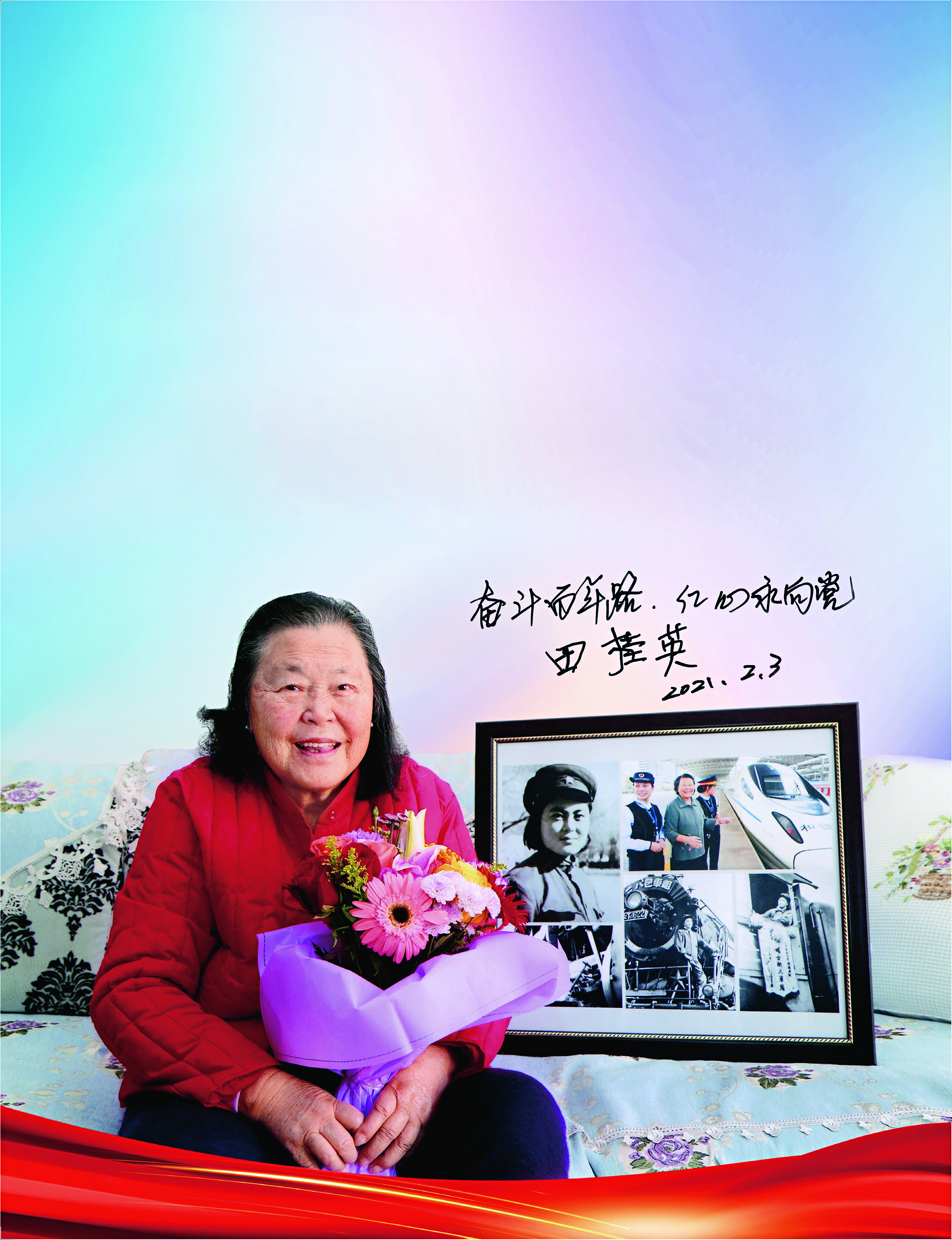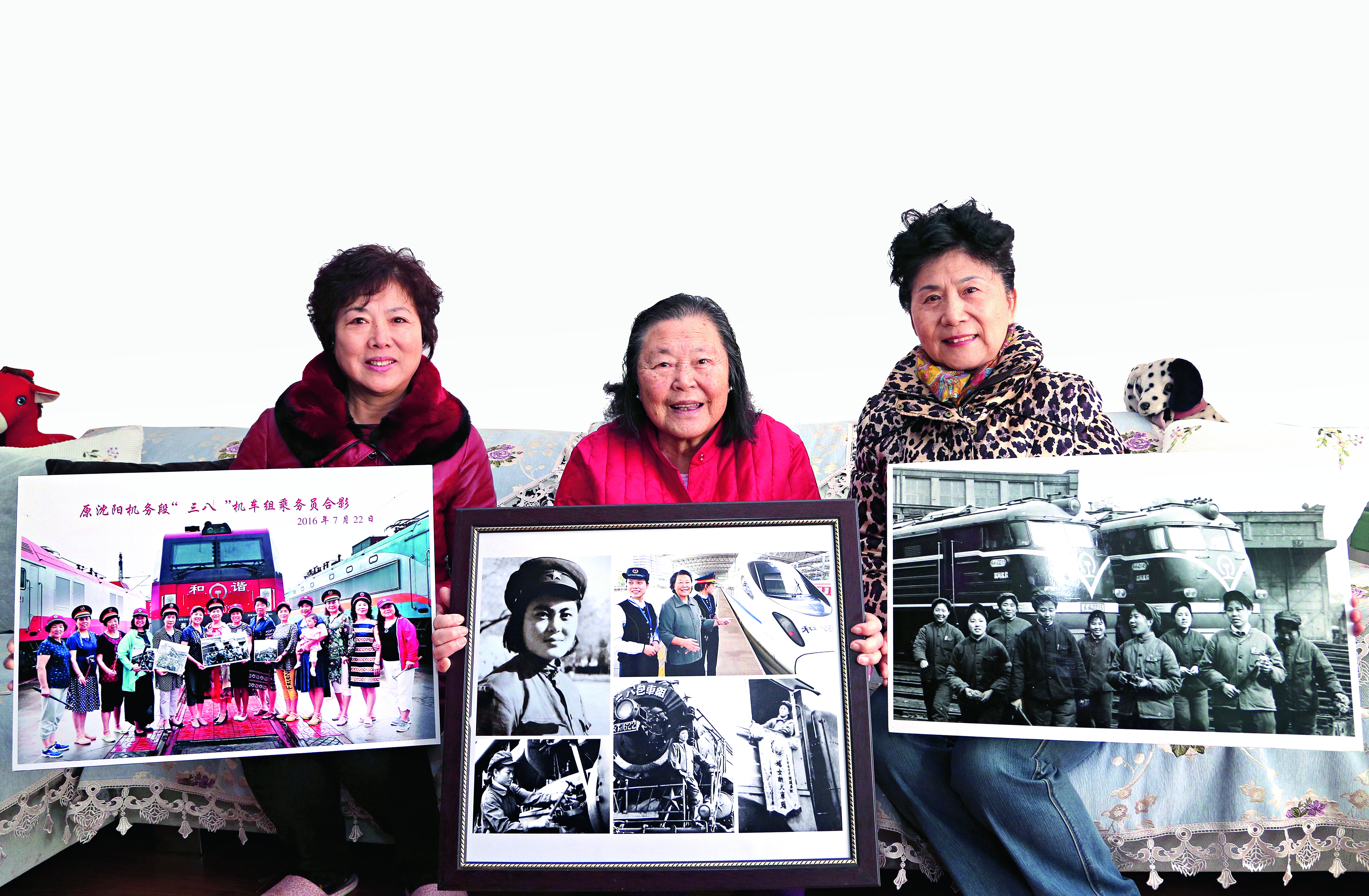Tian Guiying: China's First Woman Train Driver
 |
| This year marks the 100th anniversary of the founding of the CPC. At the age of 92, Tian Guiying writes the following words to express her love for the Party: "Striving for 100 years, I will always be loyal to the Party". [Photo by Jiang Shoukai] |
Tian Guiying joined the Communist Party of China (CPC) in 1948. She became China's first woman train driver in 1949. She was named a National Model Worker and she was received by Chairman Mao Zedong in 1950. She overcame obstacles, broke glass ceilings and pursued her ideals, and so she became a role model for thousands of young women. Tian's experiences and accomplishments were recorded in textbooks in those days, and they eventually became the basis for China's first movie about the railway industry, A Woman Chauffeur.
 |
| Tian Guiying's daughter, Yu Qian, helps her mother attach a Party emblem to the model worker's ribbon. Over the years, Yu has taken good care of her mother. [Photo by Jiang Shoukai] |
Tian likes to look at old photos when she is relaxing at home. Her favorite photos are placed in the most prominent positions around her home. One image captures the moment she met Chairman Mao, while another shows her sitting in the cab of a locomotive. In the latter photo, she looks ahead through the window and has a white towel draped around her neck.
The 91-year-old Tian seems to easily recall her youthful, passion-filled years whenever she talks about the past.
Diligent Girl from Fisherman's Family
In 1930, Tian was born into an impoverished fisherman's family, and they lived in Lüda (now Dalian), a city in Northeast China's Liaoning Province. Tian had five older sisters. The family depended on her father's fishing business to survive.
When she was 12, Tian was given the opportunity to attend school, but she dropped out two years later due to the economic difficulties experienced by her family. Tian began working at a printing factory, as an apprentice, when she was 15. Later, she was hired to sell meal tickets at the canteen of Dalian's locomotive depot.
In her spare time, Tian attended a night-school program organized by the locomotive depot. She was hungry to learn from books, which helped her expand her mind. In time, she grew determined to do something for her country, and that determination grew stronger after she witnessed China's rapid social progress.
"As long as I can learn technology, I can do anything," said Tian. After seeing Tian's ambition and passion, the head of the locomotive depot sent her to learn to drive a light-rail car.
 |
| Tian Guiying looks out of the locomotive's window. The steam train left Dalian for Lüshun on March 8, 1950. [Photo by Yu Qian] |
First Woman Train Driver in China
Tian once saw a picture of a Soviet woman train operator in the locomotive depot's staff room. She admired the woman, and she desired to one day be a train driver.
In 1949, Tian received exciting news: China planned to train its first group of women train drivers, at Dalian's locomotive depot, and was recruiting volunteers.
There were very few women working in the locomotive depot at that time. As a Party member, Tian wanted to be among the first to sign up. But when she discussed the idea with her parents, she was doused with cold water. "The job of a train driver is tiring and dangerous. It's not a suitable job for a girl," said her parents.
 |
| Tian Guiying was named a chief driver on February 25, 1950. [Photo by Yu Qian] |
Fortunately for Tian, her sisters were supportive. After serious consideration, 19-year-old Tian ignored her parents' opposition and filled out the application form.
After a strict selection process, Tian and eight other young women were chosen for the pre-job training. At that time, the trains were steam locomotives, which were run by burning coal. As such, the first step to becoming a train driver was to learn how to start the fire, and to keep it going by shoveling the coal.
The women were trained on a model locomotive, and they were tasked with shoveling coal and keeping the fire going. The job was far from glamorous, and the women were always sweaty and tired. Tian comforted her comrades, by saying, "Everything is difficult at the beginning. If we get through this, victory is just around the corner."
So, the young women encouraged each other, and they rolled up their sleeves and worked hard. Soon, their palms were covered with calluses.
Although 72 years have passed, Tian still clearly remembers every detail of the training, followed by locomotive theory, which Tian found to be even more difficult.
Every night, after they returned to the dormitory, the women discussed locomotive theory, and they didn't go to bed until they fully understood the content that was taught that day. Even after the lights were turned off, Tian would read in bed — using a flashlight.
Eventually, Tian's diligence and hard work paid off. Two months later, she passed the examination, and she stood out among the other women. She was hired, on a probationary period, as a train driver.
With a senior train driver's guidance, Tian quickly mastered the skills necessary to drive the train, and she became a "real" locomotive handler.
 |
| Tian Guiying's photo was published on the cover of Northeast Pictorial in 1950. [Photo by Zhou Chong] |
'Locomotive for Women'
A ceremony was held to mark the debut of the "March 8th Women Train Crew," composed of nine women workers, in the square in front of Dalian railway station. That ceremony was on March 8, 1950. The locomotive on which they worked was named "March 8th." The flag dedicated to them read "locomotive for women." According to Tian, "That day was so memorable. I have remembered it my entire life."
On the same day, Tian, at 20 years old, made her first train journey, as a locomotive operator. She operated the train from Dalian to Lüshun, a district of Dalian. After she entered the driver's cabin, Tian put on the operator's uniform, for the first time, with skillful movements and a committed gaze. After the roar of the horn, the first woman locomotive operator in China pulled the train out of the station; in so doing, Tian wrote a new chapter in China's railway history.
The next day, People's Daily newspaper published an article, headlined "Pioneering Work on the People's Railway! Dalian Woman Tian Guiying Drives 'March 8th' Locomotive." The story caught the attention of people across the country.
In those days, many people thought only men could drive locomotives. Thanks to their determined spirit and hard work, Tian and the eight other women not only broke the stereotype that "women can't drive trains," but also inspired women, from all walks of life, to exercise determination and confidence to make contributions to society.
"As long as we are willing to endure difficulties and work hard, women can do anything," Tian says. During Tian's nearly three years as a driver, the "March 8th" locomotive traveled more than 200,000 kilometers — without a single accident.
The movie, A Woman Chauffeur, was released nationwide in 1951. It was based on Tian's experiences, and it has long encouraged young women to serve their country. After the film's debut, Tian's name spread throughout China, and she became an idol to countless young women.
Nowadays, Chinese women can be seen working in nearly every profession, clearly demonstrating that "women can hold up half the sky."
Party's Cultivation
In 1950, at just 20 years of age, Tian was elected as one of the first group of national model workers, in recognition of her serious work attitude and excellent work-related accomplishments. In September that year, Tian was sent to Beijing to attend the national congress of model workers, farmers and soldiers. With other role models, she was received by Chairman Mao.
During that meeting, Mao asked Tian if she could start a big train. Tian was so excited that she could not speak; she simply held Mao's hand with great strength. Mao smiled and said she sure had the strength.
Tian was sent to study at a special high school, for workers and farmers in Liaoning, at the end of 1952. As a result, she had to leave the railway line, on which she had worked for nearly three years.
Tian was admitted to Tangshan Railway Institute (now Southwest Jiaotong University), in 1955, where she studied the theory of steam-powered engines in the mechanical department. Later, she worked in the Engineering Office of Shenyang Railway Bureau.
In 1985, Tian retired from Shenyang Railway Bureau, at the age of 55. Since her retirement, Tian has continued to care about the railway industry.
After China launched its nationwide railway-speed-acceleration program in 2007, Tian bought a ticket to ride on a Hexie (harmony) bullet train.
Tian sighed as she sat in the clean and bright car. "In the early days, the trains were in poor condition, cold in winter and hot in summer, and the cab didn't even have a speedometer. It was driven entirely by experience. Today, bullet trains are comfortable and fast, and the changes over the past few decades have been earth shaking," she said.
"I grew up, from a common girl in a fisherman's family to become a train driver and then an engineer, all of which was cultivated by the Party," Tian says. "I appreciate the Party, from the bottom of my heart, and I can never repay it."
 |
| Zhang Lihua and Qian Jinxiang, former chief drivers of the "March 8th Train Crew" in Shenyang's locomotive depot, visit Tian. Two generations of women train drivers talk about the great changes to China's railway industry. [Photo by Jiang Shoukai] |
(Women of China English Monthly June 2021 issue)
Please understand that womenofchina.cn,a non-profit, information-communication website, cannot reach every writer before using articles and images. For copyright issues, please contact us by emailing: website@womenofchina.cn. The articles published and opinions expressed on this website represent the opinions of writers and are not necessarily shared by womenofchina.cn.








 WeChat
WeChat Weibo
Weibo 京公网安备 11010102004314号
京公网安备 11010102004314号